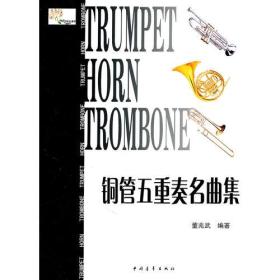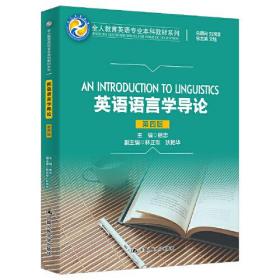
英语语言学导论
¥ 79.63 九品
仅1件
北京昌平
认证卖家担保交易快速发货售后保障
作者王会凯 著
出版社科学出版社
出版时间2014-08
版次1
装帧平装
货号A22
上书时间2024-12-12
- 在售商品 暂无
- 平均发货时间 15小时
- 好评率 暂无
- 最新上架
商品详情
- 品相描述:九品
图书标准信息
- 作者 王会凯 著
- 出版社 科学出版社
- 出版时间 2014-08
- 版次 1
- ISBN 9787030417336
- 定价 59.00元
- 装帧 平装
- 开本 16开
- 纸张 胶版纸
- 页数 150页
- 字数 245千字
- 正文语种 简体中文,英语
- 【内容简介】
-
《英语语言学导论》根据作者王会凯多年研究英语语言学的积累编写而成。全书共11章,分别是 Invitation to Linguistics; Phonetics; Phonology; Morphology; Syntax; Semantics; Pragmatics; Language, Culture and Society; First Language Acquisition; Second Language Acquisition; Linguistics and Foreign Language Teaching and Leaning。《英语语言学导论》内容紧凑精炼,语言文字简洁易懂,同时配有鲜活生动的语言材料,能进一步帮助读者理解语言学的理论。
《英语语言学导论》可以作为普通高等院校英语专业学生的教材,也可以作为中学英语教师的培训材料和英语语言学爱好者的参考读物。 - 【目录】
-
Chapter 1 Invitation to Linguistics
1.1 Linguistics
1.1.1 What is Linguistics
1.1.2 The Scope of Linguistics
1.1.3 Important Distinctions in Linguistics
1.2 Language
1.2.1 Design Features of Language
1.2.2 Origin of Language
1.2.3 Functions of Language
Chapter 2 Phonetics
2.1 What is Phonetics
2.2 Speech Organs
2.3 Phonetic Transcription
2.4 Classification of English Speech Sounds
2.4.1 Consonants
2.4.2 Vowels
2.5 Coarticulation and Phonetic Transcription
2.5.1 Coarticulation
2.5.2 Phonetic Transcription
Chapter 3 Phonology
3.1 Phoneme and Allophones
3.1.I Phoneme and Allophones
3.1.2 Contrastive Distribution and Minimal Pair
3.2 Phonological Rules
3.3 Syllable
3.3.1 Syllable Structure
3.3.2 Syllabification and the Maximal Onset Principle
3.4 Supra-segmental Features
3.4.1 Stress
3.4.2 Tone
3.4.3 Intonation
Chapter 4 Morphology
4.1 Word
4.1.1 What isaWord
4.1.2 Classification of Words
4.1.3 Word Structure
4.2 Two Fields in Morphology
4.2.1 Inflection
4.2.2 Word Formation
4.3 Morphophonology
4.4 Lexical Change
4.4.1 Phonological Change
4.4.2 Morphological Change
4.4.3 Syntactical Change
4.4.4 Semantic Change
Chapter 5 Syntax
5.1 Traditional Grammar
5.1.1 Parsing
5.1.2 Categories
5.1.3 Syntactic Relationships Between Words in Sentences
5.2 The Structural Approach
5.2.1 Immediate Constituent Analysis (IC Analysis)
5.2.2 Syntactic Relationships in Structuralism
5.3 Transformational-Generative (TG) Grammar
5.3.1 Generative Grammar
5.3.2 Transformational Grammar
5.3.3 Using PSR to Analyze Sentences
5.4 Systemic-Functional'Grammar
Chapter 6 Semantics
6.1 Meaning of "meaning" or "to mean"
6.1.1 The Naming Theory/Referential Theory
6.1.2 Meaning as Context
6.1.3 Meaning as Truth Condition
6.2 Types of Word Meaning
6.3 Lexical Sense Relations
6.3.1 Synonymy
6.3.2 Antonymy
6.3.3 Hyponymy
6.4 Componential Analysis
6.5 Sense Relations Between Sentences
Chapter 7 Pragmatics
7.1 What is Pragmatics
7.2 Micro-pragmatics
7.3 Macro-pragmatics
7.3.1 Speech Act Theory
7.3.2 Conversational Implicature
Chapter 8 Language, Culture and Society
8.1 Language, Thought and Culture
8.2 Language and Society
8.2.1 Language Variation
8.2.2 Standard and Non-standard Language
Chapter 9 First Language Acquisition
9.1 What is Language Acquisition
9.2 Theories of Language Acquisition
9.2.1 Behaviorist Theory
9.2.2 Innatist Theory
9.2.3 Interactionist Theory
9.3 Language Environment and Critical Period Hypothesis
9.3.1 Language Environment
9.3.2 Critical Period Hypothesis
Chapter 10 Second Language Acquisition
10.1 What is Second Language Acquisition
10.2 L1 Acquisition and L2 Acquisition
10.3 Approaches to L2 Acquisition
10.3.1 Contrastive Analysis
10.3.2 Error Analysis
10.3.3 Interlanguage Analysis
10.4 Factors Influencing L2 Acquisition
Chapter 11 Linguistics and Foreign Language Teaching and Learning
11.1 Introduction
11.2 Linguistic Views and Language Teaching
11.2.1 The Traditional Grammar
11.2.2 Structural Linguistics
11.2.3 Transformational-Generative Grammar
11.2.4 Functional Linguistics
11.2.5 The Theory of Communicative Competence
11.3 Syllabus Design
11.3.1 What is Syllabus
11.3.2 Types of Syllabus
11.4 Linguistics and Language Learning
11.4.1 Grammar and Language Learning
11.4.2 Language Input and Language Learning
11.4.3 Interlanguage in Language Learning
Bibliography
点击展开
点击收起
相关推荐
— 没有更多了 —





















以下为对购买帮助不大的评价